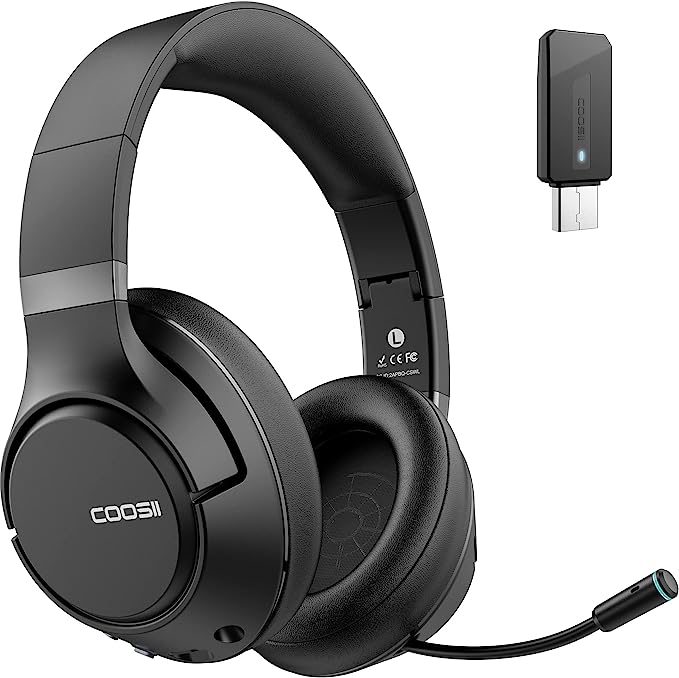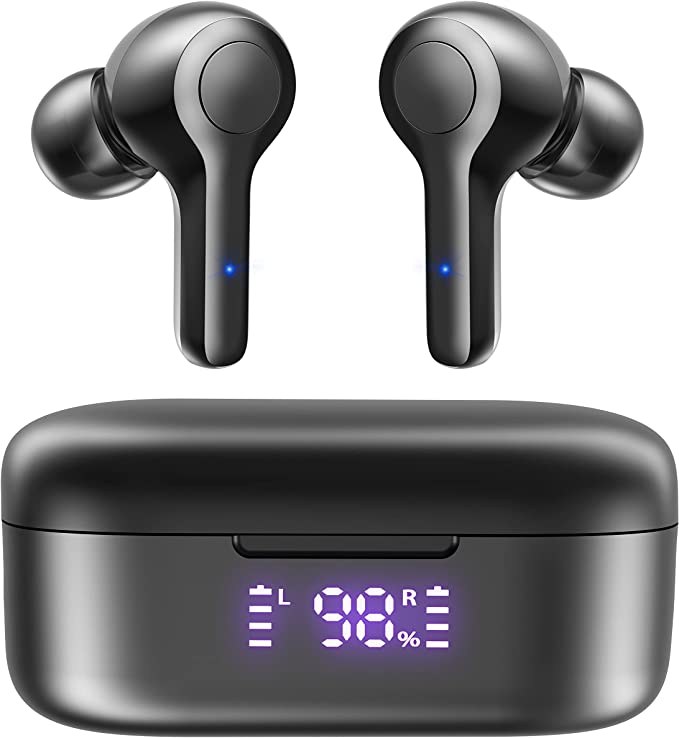In our hyper-connected world, headphones have become an almost indispensable extension of ourselves. They are our portals to immersive music, our lifelines in remote meetings, and our quiet havens in bustling environments. But have you ever paused to consider the intricate tapestry of science and engineering woven into these seemingly simple devices? Beyond the brand names and feature lists lies a fascinating world of acoustics, wireless communication, material science, and ergonomic design. Today, using the COOSII H300 Wireless Headphones as our lens, we’ll embark on a journey to explore some of these hidden symphonies of technology that strive to deliver clarity, comfort, and convenience.

The Art of Being Heard: Decoding Environmental Noise Cancellation in the Microphone
Imagine you’re on a crucial work call, trying to convey complex ideas. Your voice, however, is battling a barrage of ambient sounds – the clatter of a nearby café, the hum of an office air conditioner, or perhaps the enthusiastic chatter of your family in the next room. This is where the science of microphone noise cancellation becomes not just a feature, but a necessity. The COOSII H300 highlights its “innovative microphone ambient noise cancellation technology,” engineered to ensure your voice is the primary signal transmitted, not the surrounding cacophony.
But how does a microphone distinguish your voice from, say, a passing siren or a colleague’s conversation? It’s a sophisticated dance of acoustics and digital signal processing (DSP). While the specifics can vary, Environmental Noise Cancellation (ENC) systems often employ multiple microphones or advanced algorithms. One or more microphones might focus on capturing your voice directly (these are often directional, like cardioid microphones, which are more sensitive to sound from the front). Simultaneously, other microphones or processing stages analyze the ambient soundscape, identifying patterns that differ from human speech. The DSP then works to subtract or significantly reduce these unwanted noise signals from the primary voice input. It’s like having an intelligent audio engineer inside your headset, diligently working to isolate your speech, ensuring “crystal clear meetings” where “only your voice” is prominent.
The retractable nature of the H300’s microphone also plays a role. Proper microphone placement is crucial for optimal voice capture; being closer to the sound source (your mouth) generally improves the signal-to-noise ratio. The flexible boom allows for this precise alignment. When not needed, it tucks away neatly – a design choice that acknowledges both functionality and aesthetics. The claim of the mechanism being cycle-tested up to 3000 times speaks to an understanding that such moving parts need to be durable for daily use. Ultimately, the goal of such microphone technology is to reduce the cognitive load on both the speaker and the listener, making conversations smoother and less frustrating.

Weaving the Wireless World: Bluetooth’s Enduring Magic and the Dongle’s Duty
The liberation from tangled wires is perhaps one of the most appreciated advancements in personal audio. The COOSII H300 utilizes Bluetooth 5.0, a testament to a wireless standard that has become ubiquitous. The story of Bluetooth itself is rather charming, named after the 10th-century Danish King Harald “Bluetooth” Gormsson, famed for uniting Danish tribes – a fitting namesake for a technology designed to connect disparate devices.
At its core, Bluetooth operates in the 2.4 GHz ISM (Industrial, Scientific, and Medical) radio band, employing a technique called Frequency-Hopping Spread Spectrum (FHSS). Imagine it as rapidly switching between 79 different radio frequencies hundreds of times per second. This makes the connection robust against interference and more secure. Bluetooth 5.0 builds upon this foundation, offering improvements over its predecessors primarily in range, speed, and efficiency, particularly for Low Energy (LE) applications. While audio transmission profiles like A2DP (Advanced Audio Distribution Profile) are the workhorses for streaming music, the underlying stability and potential for higher data throughput in Bluetooth 5.0 contribute to a more reliable “hassle-free wireless” experience.
But what about devices that lack built-in Bluetooth, like older desktops or some locked-down corporate laptops? This is where the included USB dongle for the H300 becomes an unsung hero. This small device essentially acts as a dedicated, external Bluetooth radio for your computer, often pre-paired with the headset or offering a very straightforward pairing process. It can bypass potentially outdated or troublesome internal Bluetooth drivers on a PC, providing a more stable and often simpler connection. The H300 is “designed to connect to a single device at a time,” a deliberate engineering choice that helps prevent the audio interference and connectivity conflicts that can sometimes arise when a headset attempts to juggle multiple active Bluetooth sources simultaneously. And for those moments when wireless isn’t an option or you simply prefer it, the trusty 3.5mm audio jack offers a direct, analog connection – a lifeline that requires no battery and offers zero-latency audio.

The Architecture of All-Day Listening: Ergonomics and Material Science in Harmony
A headset, especially one intended for extended use in “work office meetings” or long listening sessions, must be more than just acoustically proficient; it must be comfortable. The COOSII H300 adopts an “Over Ear” (or circumaural) design, a choice rooted in ergonomic principles. By encircling the ear, over-ear headphones distribute their clamping force more broadly across the side of the head, rather than pressing directly onto the sensitive cartilage of the ear itself. This typically results in greater comfort during prolonged wear.
The science of comfort extends to the materials chosen. The H300 features “ergonomically designed over-the-ear memory foam pads” with a generous 4-inch diameter. Memory foam, or viscoelastic polyurethane foam, is remarkable for its ability to conform to unique shapes under pressure and then slowly return to its original form. This means it molds to the contours around your ears, providing a personalized fit that minimizes pressure points and enhances the acoustic seal for better passive noise isolation. This material was, famously, first developed by NASA in the 1960s to improve seat cushioning and crash protection for airline pilots.
These memory foam pads are wrapped in what is described as “durable yet soft, skin-friendly, protein leather.” Protein leather is a type of synthetic leather often made using protein powder (like eggshell protein) mixed with a resin. It’s chosen for its soft feel, often comparable to genuine leather, its durability, and its ability to “breathe” to some extent, which can help reduce heat buildup around the ears – a common complaint with some over-ear designs.
At a mere 8 ounces (approximately 227 grams), the H300 is also “lightweight.” This seemingly simple attribute is crucial. The less mass resting on your head and ears, the less strain on your neck and the lower the perceived pressure, all contributing to “all-day comfort wearing and use.” The adjustable headband, with its “thick, comfortable padding,” further allows users to tailor the fit, ensuring the weight is distributed optimally. Even the foldable design, while primarily for portability, is a nod to practical engineering.
Powering the Experience: The Unseen Energy Within
A wireless headset is only as good as its battery life. The COOSII H300 boasts “up to 40 hours of playtime on one charge” from its integrated 500mAh Lithium Polymer (Li-Po) battery. Li-Po batteries are a popular choice in modern portable electronics due to their high energy density (meaning they can store a lot of energy in a small, light package), their ability to be formed into various shapes, and generally good safety characteristics when managed properly.
Achieving such extended playtime isn’t just about the battery’s capacity; it also involves efficient power management within the headset’s circuitry. This includes the power consumption of the Bluetooth module, the audio amplifiers, and any active noise-cancellation processing. Modern chipsets are designed to be incredibly frugal with power, especially when idle or in low-power states, ensuring that the 500mAh capacity is utilized judiciously. For the user, this translates into the freedom of using the headphones for several workdays or long journeys without the constant anxiety of needing to recharge.

Intuitive Command: The Art of Simple Interaction
Advanced technology should not require an advanced degree to operate. The COOSII H300 places its controls conveniently on the right earcup, an example of designing for ease of access in Human-Computer Interaction (HCI). These include a “Volume scroll-wheel,” a dedicated “M button” for Mode switching (between USB and Bluetooth) and Mute, and a “Button with multi-functions” likely for call control (answer/end) and media playback (play/pause).
The “Smart Mute” function, a simple tap of the M button, is particularly vital in today’s world of constant virtual meetings. Having a quick, tactile way to mute and unmute your microphone provides confidence and prevents those awkward “you’re on mute” moments or, worse, inadvertently broadcasting private conversations. As one user review in the provided information noted, for their unit, pushing the microphone all the way in also muted it (though this wasn’t a universally reported feature or an official product claim for all units, emphasizing the M button as the primary mute). The little blue light on the microphone, indicating it’s active, is another small but thoughtful touch that provides immediate visual feedback. These control elements, while seemingly minor, significantly contribute to a smoother and more professional user experience.
A Symphony of Sciences for Everyday Utility
The COOSII H300 Wireless Headphones, like many well-designed pieces of technology, are a culmination of advancements across multiple scientific and engineering disciplines. From the acoustic principles that enable clear voice capture in noisy environments to the radio frequency engineering behind stable Bluetooth connections, the material science that delivers hours of comfort, and the ergonomic considerations that make them feel like a natural extension of the user – it’s a quiet symphony of innovation.
These headphones are designed to integrate seamlessly with the tools we use daily, “designed to work seamlessly with Zoom, Skype, Google Hangouts, FaceTime, WebEx, GoToMeeting, and other leading conferencing platforms.” This broad compatibility, coupled with the blend of reliable performance and user-focused design, reflects COOSII’s stated philosophy of “infusing the best audio technology into every product” and “blending style with professionalism.”
Ultimately, understanding the science embedded in such devices doesn’t just satisfy curiosity; it allows us to appreciate the thoughtful engineering that aims to make our increasingly digital lives a little clearer, more comfortable, and more connected. The journey of audio technology continues, constantly refining how we hear and are heard, one meticulously designed component at a time.




